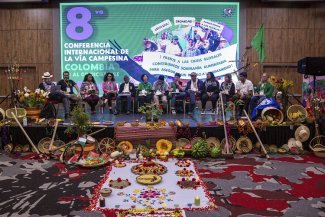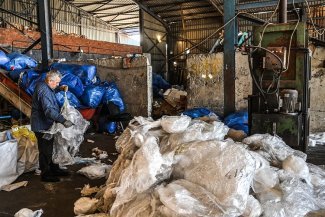Exporting manufactured goods has been a common development strategy for many countries. But a race to the bottom on working conditions means that this has had horrific consequences on women’s economic inequality.
A new report by ActionAid, What a way to make a living, argues that industrialisation must not and need not be based on the exploitation of women living in desperate poverty.
The report is just the start of our contribution to this conversation, where unions and workers’ organisations are playing a central role.
Women dominate the workforce in labour-intensive sectors like horticulture, garments and footwear, and assembly work. Deep-rooted gender discrimination means that employers can get away with paying women less than men would receive for the same work, and much less than their labour is worth.
Shilpy left school at the age of eight and joined her parents in one of Bangladesh’s many garment factories when she was just 12.
“Garment workers were never respected in our society. If the factory owners know that their employees are not aware of their rights, then they will try to exploit them. We used to work 14 or 15 hour days, we didn’t get any leave, and often the wages we did earn were paid a month late,” she says.
Conditions improved once Shilpy got involved in one of ActionAid’s workers’ rights groups. But efforts by garment workers themselves can only go so far.
Few and exploitative jobs lead to a dead end
Each year, Bangladesh’s working-age population grows by more than 2 million people but, on average, only 200,000 jobs are created.
The lack of decent jobs on offer in Bangladesh and elsewhere means that women entering the workforce are pushed into informal or precarious jobs, often in dangerous working environments.
The Rana Plaza factory collapse in April 2013, where 1,134 garment workers lost their lives, is testament to the unsafe conditions endured by Bangladeshi women. And despite massive international pressure to reform the export garment industry, many dangers remain.
Meanwhile, women continue to be disproportionately responsible for unpaid care and domestic work.
As a recent report by UN Women argues, “rather than incorporating more women into increasingly precarious and unrewarding forms of employment, labour markets must be transformed in ways that work for both women and men and benefit society at large.”
Industrial economists tend to be blind to the way that gender, social relations and vital unpaid care work interact with the development of manufacturing.
But ActionAid believes that it is eminently possible to promote industrialisation in a way that tackles women’s economic inequality at the same time.
Kicking off the race to the top
ActionAid’s report argues that governments should cooperate with their regional neighbours to catalyse a race to the top on workers’ rights and wages, and to prevent a race to the bottom on tax incentives.
Governments also need to implement laws and policies that guarantee women equal pay and equal access to job opportunities as men. Profitable businesses can generate the tax revenue to fund the public services that are so important for women, allowing them to reduce the amount of time they spend on unpaid care and domestic work.
As Lourdes Beneria, Günseli Berik and Maria Floro argue in their book Gender, development and globalization: economics as if all people mattered: “Majorities everywhere have to engage in activism to bring about political and long-term economic reforms, to tackle inequality in its various forms and launch economies on sustainable paths.”
We hope that we can join together to make this happen.









